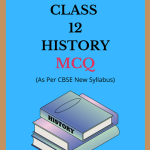NCERT Class 12 History MCQ Chapter 12 Colonial Cities Solutions to each chapter is provided in the list so that you can easily browse through different chapters NCERT Class 12 History MCQ Chapter 12 Colonial Cities and select need one. NCERT Class 12 History MCQ Chapter 12 Colonial Cities Question Answers Download PDF. NCERT History MCQ Class 12 Solutions.
NCERT Class 12 History MCQ Chapter 12 Colonial Cities
Also, you can read the NCERT book online in these sections Solutions by Expert Teachers as per Central Board of Secondary Education (CBSE) Book guidelines. CBSE Class 12 History MCQ Solutions are part of All Subject Solutions. Here we have given NCERT Class 12 History MCQ Part – I: Themes in Indian History, History MCQ Part – II: Themes in Indian History, History MCQ Part – III: Themes in Indian History. NCERT Class 12 History MCQ Chapter 12 Colonial Cities Notes, NCERT Class 12 History MCQ Notes for All Chapters, You can practice these here.
Colonial Cities
Chapter: 12
| THEMES IN INDIAN HISTORY (PART – III) |
| MCQ |
1. Three big colonial cities of India are:
(a) Madras (Chennai) Calcutta (Kolkata) and Bombay (Mumbai).
(b) Panji, Pune and Patna.
(c) Delhi, Amritsar and Lahore.
(d) Surat, Chand Nagar and Chandigarh.
Ans: (a) Madras (Chennai) Calcutta (Kolkata) and Bombay (Mumbai).
2. Bombay was given to the English East Indian Company in 1661 by:
(a) The English King.
(b) The Dutch King.
(c) The French King.
(d) None of the above.
Ans: (a) The English King.
3. The King of England has got Bombay as part of his wife’s dowry from:
(a) The King of France.
(b) The King of Portugal.
(c) The King of Russia.
(d) The King of Prussia.
Ans: (b) The King of Portugal.
4. Fort St. George was at:
(a) Delhi.
(b) Madras.
(c) Goa.
(d) Calcutta.
Ans: (b) Madras.
5. Mirza Ghalib was a famous:
(a) Politician.
(b) Sufi Saint.
(c) Urdu Poet.
(d) A Mughal court Painter and Dancer.
Ans: (c) Urdu Poet.
6. Shahjahanabad was founded by:
(a) Shaha.
(b) Sirazudaulah.
(c) Shahjahan.
(d) Akbar.
Ans: (c) Shahjahan.
7. During the Mughal period the three important centres of imperial administration and control were:
(a) Agra, Delhi and Lahore.
(b) Surat, Dhaka and Multan.
(c) Ajmer, Fatehpur Sikri and Joahpur.
(d) Peshawar, Patna and Ahmedabad.
Ans: (a) Agra, Delhi and Lahore.
8. Ganj refers to a:
(a) Very big but mobile market.
(b) Small fixed market.
(c) Temporary market of a metro.
(d) Market of Banjaras and nomads.
Ans: (b) Small fixed market.
9. The Portuguese had set up their commercial base in Panaji in:
(a) 1510.
(b) 1605.
(c) 1639.
(d) 1673.
Ans: (a) 1510.
10. Who set up their commercial base in 1605 in Masulipatnam?
(a) The French.
(b) The Dutch.
(c) The Portuguese.
(d) The English.
Ans: (b) The Dutch.
11. Who settled as main European traders in Pondicherry (or present-day Puducherry) in 1673?
(a) The Danish.
(b) The French.
(c) The Dutch.
(d) The Portguese.
Ans: (b) The French.
12. Before European companies the main three commercial centres of India were:
(a) Ahmedabad, Srinagar and Patna.
(b) Surat, Masulipatnam and Dhaka.
(c) Madurai, Lucknow and Multan.
(d) Jammu, Pune and Mysore.
Ans: (b) Surat, Masulipatnam and Dhaka.
13. The first all India census was attempted in:
(a) 1872.
(c) 1842.
(b) 1852.
(d) 1822.
Ans: (a) 1872.
14. From which year decennial (conducted every ten years) census began in India:
(a) 1781.
(c) 1758.
(b) 1881.
(d) 1858.
Ans: (b) 1881.
15. Fort St. George of English East India Company was at:
(a) Calcutta.
(b) Bombay.
(c) Madras.
(d) Bangalore.
Ans: (a) Calcutta.

Hi! my Name is Parimal Roy. I have completed my Bachelor’s degree in Philosophy (B.A.) from Silapathar General College. Currently, I am working as an HR Manager at Dev Library. It is a website that provides study materials for students from Class 3 to 12, including SCERT and NCERT notes. It also offers resources for BA, B.Com, B.Sc, and Computer Science, along with postgraduate notes. Besides study materials, the website has novels, eBooks, health and finance articles, biographies, quotes, and more.




